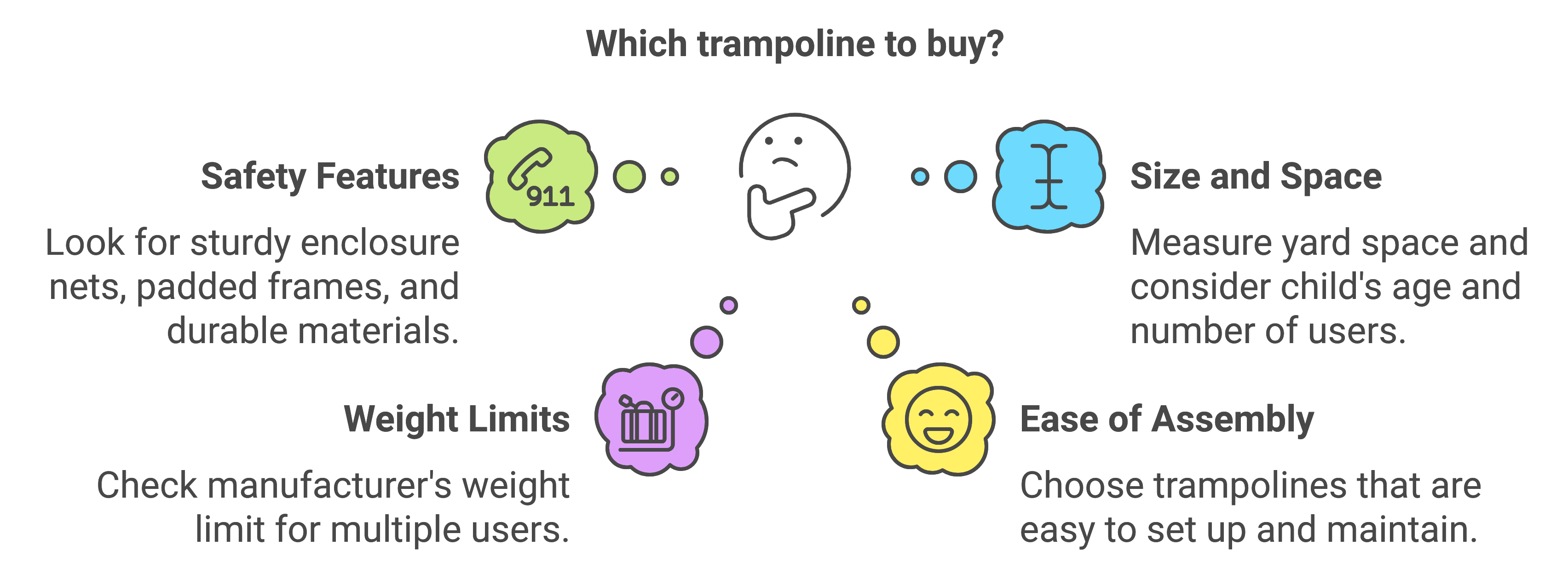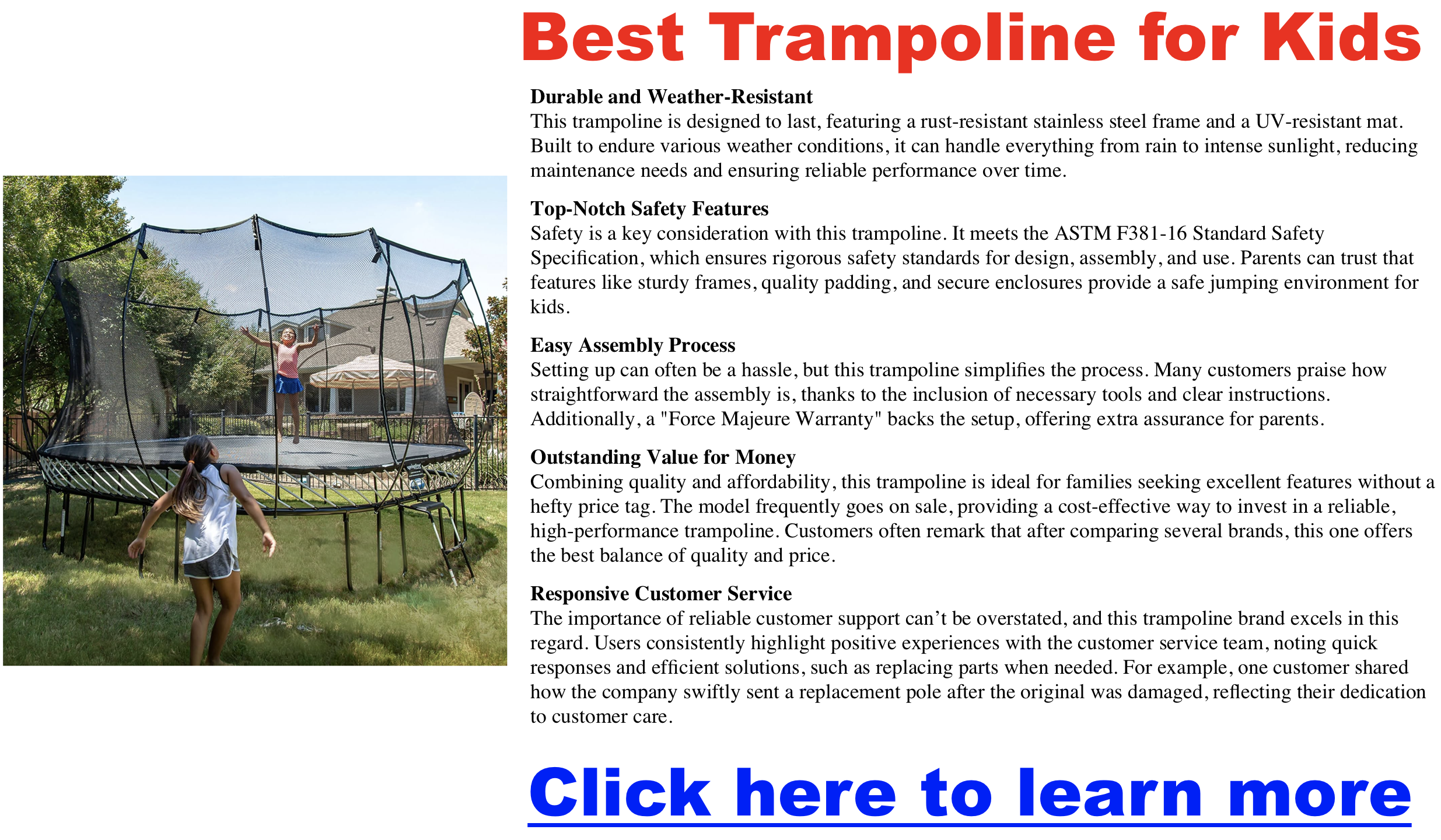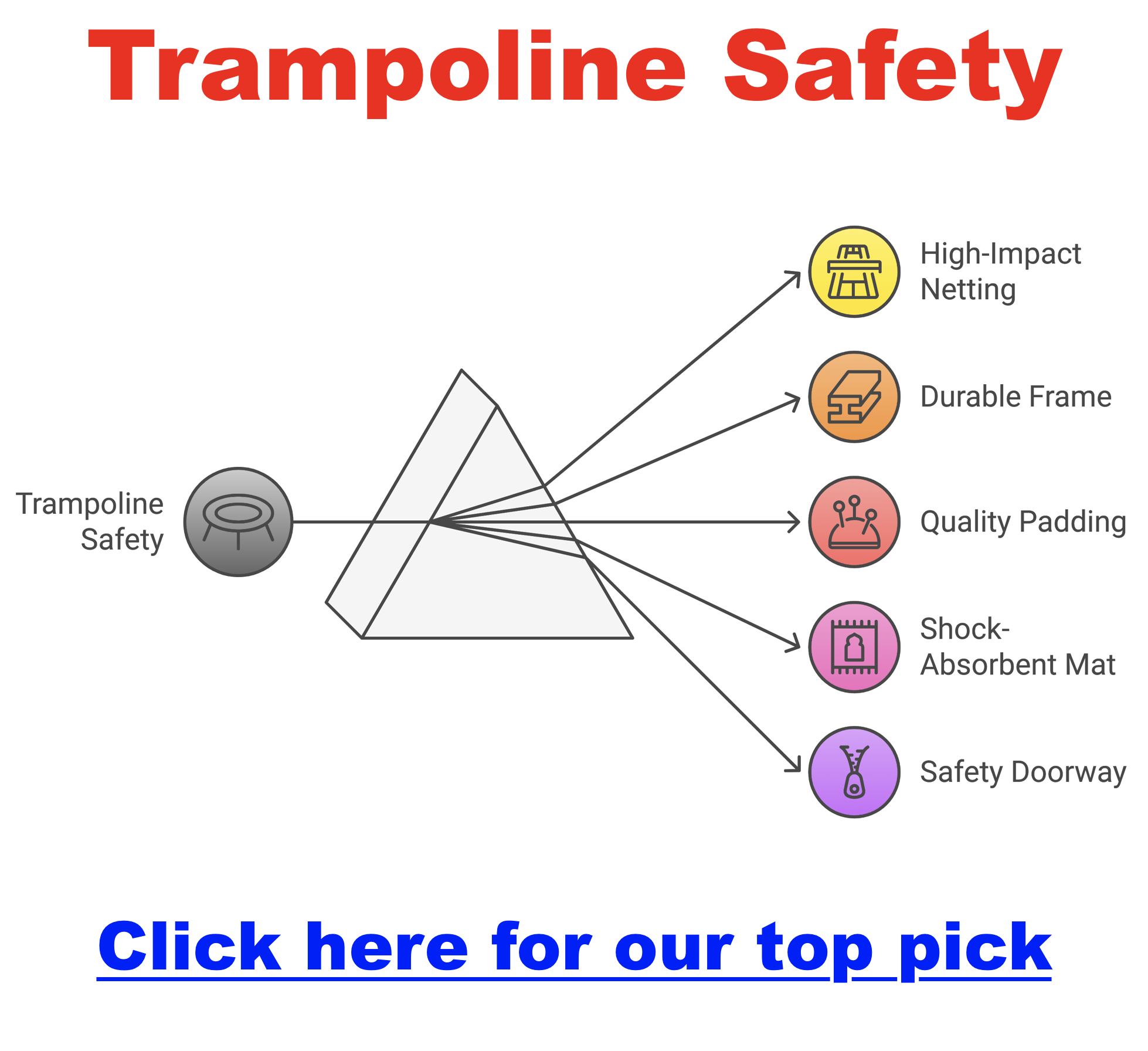Best Trampoline for Kids
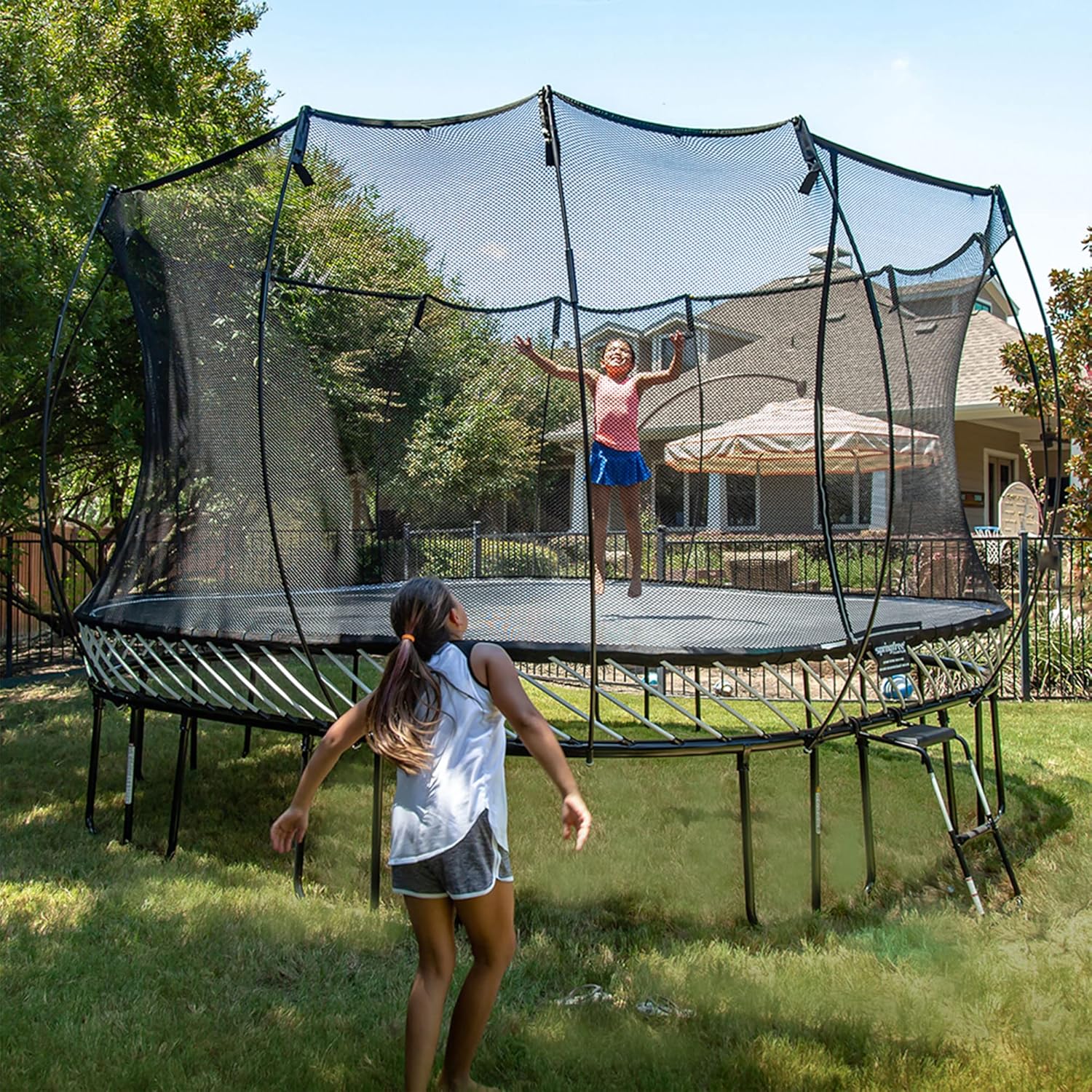
Click here for the overall top trampoline pick for kids
Choosing a trampoline for your kids can be exciting but also a big decision. With so many options out there, it’s important to focus on safety, quality, and durability to make sure you’re getting the best one. In this guide, we’ll walk you through some of the top trampolines for kids and share key factors to help you pick the right one for your family.
👉 Before you decide on a trampoline for your kits, grab our free Trampoline Buying Guide. It includes a detailed buying guide to help you choose the right trampoline and a safety checklist to keep your kids safe while they bounce. Get it here.
Best Trampoline for Kids
Springfree Square Backyard Trampoline with Enclosure
- Safety Features: Look for trampolines with sturdy enclosure nets, padded frames, and durable materials. Consider springless designs that eliminate common hazards like pinched fingers.
- Size and Space Requirements: Measure your yard and ensure there’s at least 2-5 feet of clearance around the trampoline. The right size depends on your child’s age, number of users, and available space.
- Weight Limits: Check the manufacturer’s weight limit to ensure the trampoline can handle multiple users safely.
- Ease of Assembly and Maintenance: Choose trampolines that are easy to set up and maintain. Regular inspections for wear and tear are necessary to keep the trampoline safe and functional.
Click here for the overall top trampoline pick for kids
Types of Trampolines for Kids
Click here for the overall top trampoline pick for kids
- Round Trampolines: Common for recreational use, they provide an evenly distributed bounce.
- Rectangular Trampolines: Preferred by gymnasts for a more powerful and controlled bounce.
- Square Trampolines: Combine the benefits of round and rectangular shapes, offering more jumping space with consistent bounce.
- Mini and Toddler Trampolines: Smaller models designed for indoor use, often with handles for added safety.
Best Trampolines for Kids
| Brand | Key Features | Shape Options | Weight Capacity | Click for Price |
|---|---|---|---|---|
| Springfree | Springless design, SoftEdge™ Mat | Round, Square, Oval | Up to 1,500 lbs | $$$$ |
| Skywalker | No-gap design, ASTM certified | Round, Rectangular, Oval | Up to 400 lbs | $$ |
| Acon Air | High flow bed, performance springs | Round, Rectangular | Multiple users | $$$ |
| Jumpflex | High-tensile steel frame, no-gap design | Round | Up to 550 lbs | $$$ |
| Jumpzylla | Rust-resistant, UV-resistant materials | Round | Varies | $$ |
Top Picks: Best Trampolines for Kids
Based on safety, quality, and user reviews, here are some of the best trampolines for kids:
Springfree Trampoline Jumbo Square
- Key Features: Springfree trampolines are designed with safety as the top priority. Instead of traditional springs, they use flexible composite rods beneath the jumping surface, which eliminates the risk of injuries. Other safety features include the SoftEdge™ Mat, a hidden frame, and the FlexiNet® enclosure.
- Shape Options: Available in round, square, and oval shapes.
- Weight Capacity: Up to 1,500 pounds.
- Why It’s Great for Kids: The innovative design minimizes risks, making it an excellent choice for families who prioritize safety.
Skywalker Trampolines – Jump-N-Dunk
- Key Features: Known for affordability and safety, Skywalker trampolines include tightly-woven enclosure nets, a no-gap design, and meet ASTM safety standards.
- Shape Options: Round, rectangular, and oval.
- Weight Capacity: Up to 400 pounds, depending on the model.
- Why It’s Great for Kids: A budget-friendly option without compromising safety. The no-gap design reduces the chance of accidents, making it ideal for younger children.
- Key Features: Durable with high-quality bounce, Acon Air trampolines feature a ‘high flow‘ bed that reduces air drag, enhancing performance. Users commend the brand for its long-lasting construction.
- Why It’s Great for Kids: Ideal for active children who enjoy high-energy bouncing, with strong materials that ensure the trampoline holds up over time.
- Key Features: Built with high-tensile steel frames, 360-degree safety nets, padded poles, and a no-gap design to ensure safety.
- Weight Capacity: Can hold up to 550 pounds.
- Why It’s Great for Kids: Combines a sturdy build with robust safety features, making it suitable for multiple users.
- Key Features: Designed with rust-resistant steel frames and UV-resistant mats, Jumpzylla trampolines adhere to ASTM F381-16 safety standards.
- Why It’s Great for Kids: Prioritizes safety and durability, making it a reliable pick for families looking for a trampoline that will last.
Safety When Choosing a Trampoline for Kids
Springless Trampolines
Springless trampolines, especially those produced by Springfree, are highlighted as one of the safest options available. Traditional trampolines use metal springs that pose a significant injury risk, as children may get their fingers or toes caught. Springless models, like Springfree’s, eliminate this hazard by using flexible composite rods or elastic bands beneath the jumping surface. This design prevents exposure to dangerous parts and provides a smoother, more controlled bounce. More on trampoline safety features here.
Key Safety Features:
- SoftEdge™ Mat: This mat, exclusive to Springfree, is 30 times more shock-absorbent than standard trampoline pads, reducing the risk of injuries from falls.
- Hidden Frame: The frame is placed beneath the jumping surface, out of the way of jumpers, to eliminate the possibility of contact.
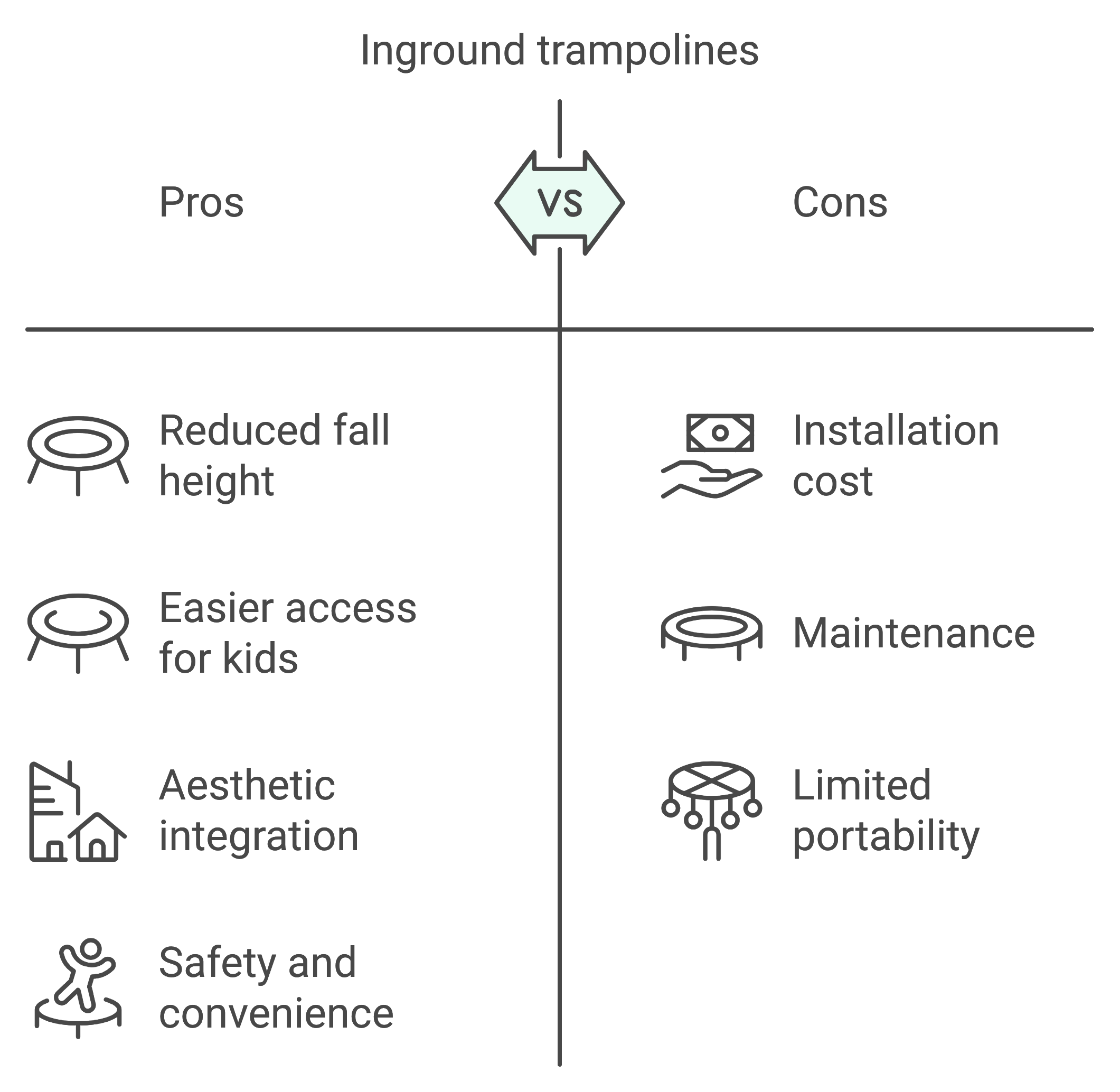
Inground Trampolines
Inground trampolines are installed at ground level, reducing the fall height and minimizing the risk of serious injuries. These trampolines are easier for younger children to access and can be integrated aesthetically into outdoor spaces. They are a popular choice for families looking to blend safety with convenience.
Why They’re Safer:
- Reduced Fall Height: Being at ground level means there’s less distance to fall, lowering the risk of injury.
- Easier Access: Younger kids can easily get on and off without climbing, reducing the chance of accidental slips.
Traditional Trampolines with Enhanced Safety Features
Even traditional spring trampolines can be safe if they include the right safety enhancements. Here are some features to prioritize:
- High-Impact Enclosure Netting: Keeps jumpers within the safe jumping area and prevents falls.
- Durable Frame Construction: A sturdy frame, often made of galvanized steel, prevents tipping or collapsing.
- Quality Padding: Thick padding over springs and frame edges helps cushion any accidental contact, minimizing injury risks.
- Shock-Absorbent Mat: High-quality mats can absorb impacts effectively, providing a safer jumping experience.
- Safety Doorway Options: Enclosures should have secure entry points, such as zippers or overlapping designs, to prevent accidental openings.
Top-Rated Brands for Safety
Certain brands consistently stand out for their dedication to safety:
- Springfree: Known for their innovative springless design, Springfree trampolines are regarded as some of the safest on the market. Independent safety bodies have given them a 100% performance rating, and they’ve eliminated 90% of trampoline-related injuries.
- Skywalker: This brand focuses on affordability without compromising safety, featuring tightly-woven enclosure nets, no-gap designs, and rigorous ASTM safety testing.
- Jumpflex: Offers a sturdy build with comprehensive safety features, including a 360-degree safety net that extends to the bottom of the mat, padded poles, and UV-resistant netting.
- Acon Air: Renowned for durability and performance, Acon Air trampolines also integrate safety features like upgraded springs and a high-flow bed for controlled, safe bouncing.
- Jumpzylla: These trampolines prioritize safety and adhere to ASTM F381-16 standards, ensuring safe design, components, and assembly.
Additional Safety Considerations
To ensure a safe trampoline experience, consider the following practices:
- Proper Setup: Always install the trampoline on a flat, level surface with sufficient clearance above and around it. Soft ground beneath the trampoline can help absorb impact from falls.
- Maintenance: Regularly inspect the trampoline for wear or rust on the springs, frame, jumping mat, and net. Promptly repair any signs of damage.
- Supervision: Never leave children unattended on the trampoline. Establish rules, such as no flips or roughhousing, to reduce the risk of accidents.
- Weight Limits: Respect the manufacturer’s specified weight limits to prevent overloading, which can lead to damage or injuries. Skywalker weight limits. Springfree weight limits.
- Age Appropriateness: Most sources recommend a minimum age of 6 for using a full-size trampoline. Younger children should stick to mini trampolines designed specifically for their age and size.
Essential Safety Tips for Parents
- Supervision and Usage Rules: Always supervise children and set rules for safe play, such as one jumper at a time.
- Proper Use Recommendations: Encourage children to jump in the center and avoid dangerous stunts.
- Maintenance Checks: Regularly inspect for rust, loose springs, and tears in the mat. Replace any damaged parts promptly.
Frequently Asked Questions (FAQ)
What Shape of Trampoline Is Best for Kids?
- Round trampolines are ideal for younger kids due to their consistent bounce, while rectangular trampolines are better for older, more active children who may want to practice tricks.
How Much Space Do I Need for a Trampoline?
- Ensure there is at least 2-5 feet of clearance around the trampoline. Measure your available yard space and consider overhead clearance as well.
Are Springless Trampolines Safer Than Traditional Ones?
- Yes, springless trampolines eliminate the risks associated with exposed springs, such as pinched fingers or toes.
What’s the Right Size Trampoline for My Child’s Age?
- Smaller trampolines (6-8 feet) are better for younger children, while larger ones (12-15 feet) are suitable for older kids and multiple users.
How Do I Maintain My Trampoline to Ensure Longevity?
- Regularly check for wear and tear, clean the mat, and use a cover during harsh weather. If possible, store it indoors during winter to extend its lifespan.
Can Adults Use These Trampolines?
- Yes, as long as the weight limit is not exceeded. Many trampolines are designed to accommodate both kids and adults.
What Are the Benefits of Trampoline Exercise for Kids?
- Jumping on a trampoline improves cardiovascular health, balance, and coordination. It’s also a great way to boost mood and reduce stress.

